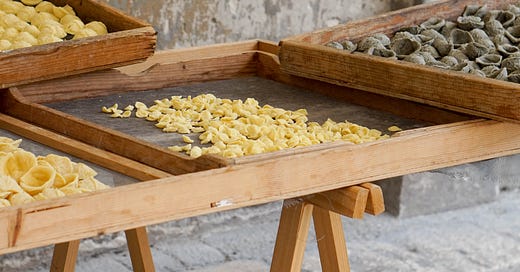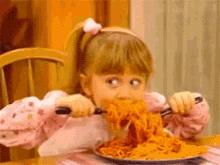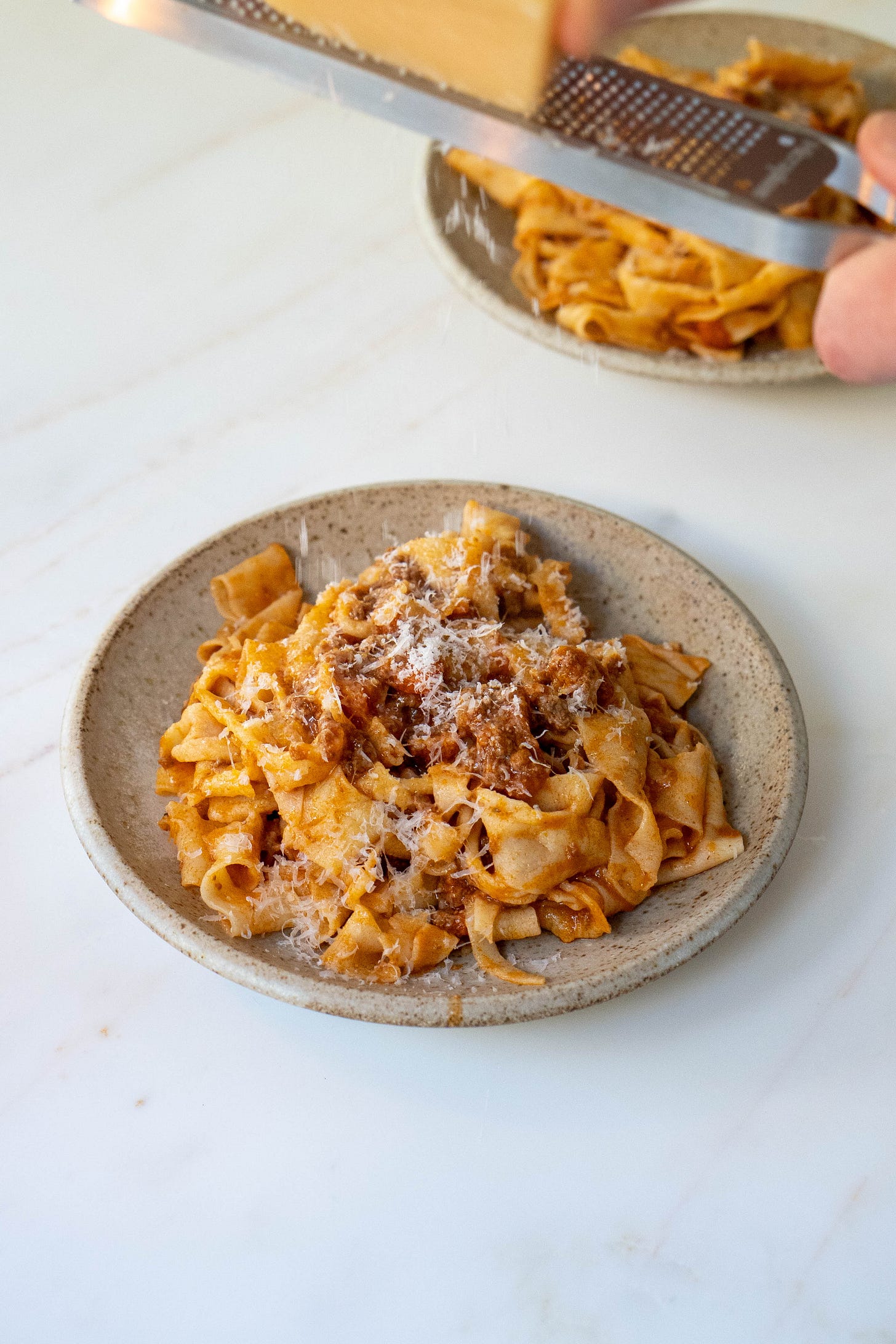A biased review of Pasta shapes.
Not all Pasta shapes are created equal. I am looking at you, Penne Lisce.
The first thing you should know about pasta shapes is that there are too many to remember, even for an Italian (and if anyone claims the contrary, they are almost certainly lying). If one adds up all the obscure regional varieties, we’d tally at around 300. Crazy, I know.
That is precisely why this article is not meant to be an extensive overview of the topic, nor (as the title suggests) a particularly objective one.
I won’t go into the difference between dry and fresh pasta, egg vs semolina, (I’m assuming you already know that) and I am also purposefully skipping ravioli & stuffed pasta altogether: the combinations and shapes are endless, and life is too short. This a deep dive into my personal pasta preferences and pet peeves, and you are welcome to disagree with me (in fact, I’d love to hear what your favourite pasta types are!).
Spaghetti (no.5)
We start from the quintessential pasta archetype: the humble Spaghetto, which literally translates as small string. There is a reason why Spaghetti are the most famous pasta shape in the world: you can never go wrong with them and they pair with pretty much everything. You could see them as the food equivalent of a white t-shirt (although I wouldn’t recommend wearing one as you eat them). So it shouldn’t shock you to hear me say it’s my favourite style of pasta (and if that makes me a basic b**ch, so be it): my preferred way to enjoy a bowl of spag (very different to a spag bol) is always with a simple tomato sauce with lots of garlic (no onion), fresh basil and a healthy dose of Parmigiano – a very nostalgic flavour to me. Speaking of Parmigiano: the purists will say you categorally must refrain from using it on fish sauces. But with everything in life, I like to take a case-by-case approach.
You might not know this, but in Italy there are many types of spaghetti, coded by a number which indicates how thick they are: much like with the Chanel perfumes, no.5 is the most common and versatile type, whereas no.3 is slightly thinner and no.8 slightly thicker. These numbers refer to Barilla’s coding (the most ubiquitous pasta brand in Italy), but each brand then has its own other numbers, which I appreciate is slightly confusing.
Now, because of their worldwide popularity, spaghetti also find themselves in the very unique position (compared to all other pasta shapes) of being quite severely mishandled: horror stories that make us Italians shiver, like the popular belief you should throw them to a wall to see if they stick to test if they are ready (after all, why simply bite them when you can redecorate your kitchen at the same time); the equally widespread (and frowned upon) habit of eating them with the aid of a spoon (the first tell sign you are a tourist if you are caught doing it in Italy), or worse – cutting them into smaller pieces with a knife. This latter practice is only acceptable if you are feeding a child or using them in a soup, and at that point, you might as well just buy pre-cut spaghetti (yes we sell those as well).
Otherwise, a swift swirling of the fork in a clockwise motion is the correct way to tackle spaghetti. Pro tip: make sure you stab roughly 4-5 strings before you start twisting, or you’ll end up with an impossibly big mouthful!
The extended Spaghetti family
If you are feeling fancy, there are a number of close relatives to the spaghetti: “siblings” include the squarish Spaghetti alla Chitarra, the straw-like Bucatini (particularly handy to slurp a runny sauce), the hefty and wonderfully coarse Bigoli (a Venetian speciality) and the handmade Tuscan Pici.
One step removed, we have all the “flat cousins” – your Fettucine ( it’s pronounced fettuccineh, not fettuccinee), your Tagliatelle (Tagliatelleh, you get the gist), Tagliolini (thin Tagliatelle) and Pappardelle (wide Tagliatelle) etc.
If Spaghetti are your everyday workhorse, these other types are reserved for slightly more special occasions (at least, I do): the weekend, a meal out, or when you have guests round.
The sauces also tend to be posher: I’m thinking fish (clams, prawns or bottarga) for the Chitarra, Amatriciana for Bucatini and the traditional duck ragu for Bigoli. The Flat Cousins in particular are often paired with a meaty sauce (a traditional Ragu alla Bolognese for tagliatelle, or a Wild Boar ragu is heavenly on Pappardelle).
Paccheri
The short king of the pasta world is undoubtedly the Pacchero. This is a cylindrical shape, about 3cm wide and 5 high, which collapses into a sauce trap of bliss when cooked. Bridging the gap between the Flat Cousins and short pasta, Paccheri offers the best of both worlds: ease of forking AND a generous flat clinging surface for the sauce. Each Pacchero is a perfectly self-contained parcel of flavour, and I won’t hear a bad word about them.
Although the above-mentioned sauces would work well with Paccheri, nothing beats, in my opinion, a good alla Norma sauce (fried fresh tomato, fried aubergines and a grating of smoked ricotta salata).
Penne Rigate
Sitting comfortably at the podium of my very personal scale of preference, we have Penne, but with a huge caveat: it is vital that you get the Rigate type, which means the pasta is scored with thin vertical lines that provide very useful clinging opportunities for the sauce. The alternative, Penne Lisce, is a smooth, slippery slope of sadness and hence absolutely pointless, and you should distrust anyone who claims to prefer Penne Lisce to Pinne Rigate.
Penna’s brother is called Rigatone (a slightly buffer type with a straight jaw-line). Where Penne works wonderfully with a simple tomato sauce (Marinara, with plenty of garlic and oregano, or Alla Vodka), I would pair Rigatoni with one of the ragu listed above.
Farfalle
Farfalle in three words? Not a fan. Yes, they look cute, with their pretty bow shape and that neat pinch in the middle. But the truth is, that shape was not conceived with practicality in mind, and it’s nearly impossible to achieve an even cook, so you’ll either end up with a hard centre or overcooked wings. In the words of Ariana, thank you, next.
Orecchiette (lit. little ears)
This type of pasta will always hold a sentimental value to me, but more so for what it evokes rather than its intrinsic virtues (although the little cup-like shape holds sauce really well). It will always remind me of summer holidays spent in Puglia, admiring the nonne lining the streets in downtown Bari shooting out orecchiette with the speed of light armed only of a humble table knife. To eat at one of these grandma’s houses is a bucket-list-worthy experience, if you ask me. Orecchiette will also always remind me of my husband Joe and his incredibly cute and dandy little ears, which I praise often, and without him feeling emasculated even one bit, as you can imagine.
Orecchiette are traditionally accompanied by cime di rapa (turnip greens), but they also work with sausage, beans, broccoli or a simple butter, anchovy and fried breadcrumbs affair.
Malloreddus
Also known as Gnocchetti Sardi, this is one of the easiest and most satisfying pasta shapes to try making at home (you can learn how in this Reel I created some time ago). All you need is semolina flour, salt, water and a fork. It’s a great way to get your kids involved and spend a rainy afternoon. Great alla Sorrentina (tomato and mozzarella sauce) or with Pesto.
Cavatelli
Equally fun and even easier to make with your hands are Cavatelli, a smoother, slightly more oblong version of Malloreddus. As they come from the same land as Orecchiette, the same pairings would work here, but I would have them alla Puttanesca (tomato sauce with olives, capers, anchovy, garlic and chilli, if you like) or with a creamy cheese sauce like a Cacio e Pepe.
Fusilli
If you have followed my line of reasoning so far, you’d think I would be all up for Fusilli. After all, what could trap more sauce than a pasta shape that looks like it has been designed by a nautical engineer? Surely its helical shape would guarantee an optimum sugo retention level? On paper, yes. The truth is, unless we are talking about a simple tomato sauce (and let’s be honest, everything goes with a tomato sauce), the spiral is too tightly wound to trap anything of substance; this might be why it is the most popular pasta shape used in Paste Fredde (what you’d call Pasta Salads), where – much like awkward teenagers or a silent retreat – each item is to their own and they are not really expected to mingle.
P.s.
If you are interested in learning more about other more obscure pasta shapes, I would recommend this old and fabulous book (from a graphic design point of view too).









Whenever I go to a new region I get so frustrated that I can’t read the menu because the pasta shapes are so regional! I’m glad to know that even Italians have trouble knowing all the pasta shapes.
Loved this and I have so many pasta questions for a future part two… Maybe the comments can double up as a pasta-themed ask (you) anything?! 😅
1. Do Italians think al dente is the best way? (Thinking specifically of Brutto’s vodka penne, which can sometimes be verging on firm enough to break a tooth)
2. Is dried pasta ever better than fresh?
3. What are your feelings on egg pasta? Is it better suited to certain dishes?
4. Aside from pici, do you always need a pasta roller to make pasta at home?
5. What is your go-to, never-fails pasta sauce recipe? Can you recommend one?
6. Do Italians ever have garlic bread to dip in their pasta sauce?
7. Who makes your favourite pasta in London?